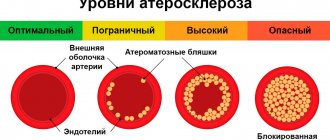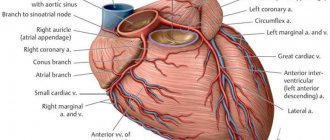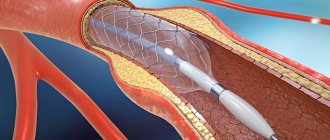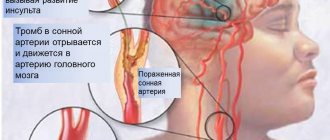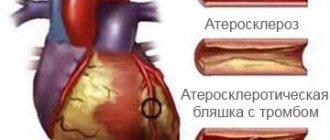21 Feb 2021 at 12:11 Complex MRI 14773
Diseases of the cardiovascular system still occupy one of the leading places among ailments leading to death or disability. A decrease in the patency of blood vessels negatively affects the quality of work not only of individual organs, but also of the entire body. One of the most dangerous manifestations that can occur in the cardiovascular system is blockage of blood vessels in the brain, lower extremities and heart.
Symptoms
Signs of atherosclerosis do not appear immediately. The first stages of atherosclerosis of the heart vessels are asymptomatic. The disease makes itself felt when the coronary artery becomes so blocked that it no longer supplies the heart with enough blood. A blood clot can completely block blood flow, causing a heart attack.
The main sign of severe atherosclerosis is burning or pressing pain in the chest, which initially bothers you during physical activity or in a stressful situation. This syndrome is called cardiac angina. Pain can be felt behind the sternum, radiating to the left arm, shoulder girdle and jaw. In addition to the feeling of constriction, a person is worried about shortness of breath, weakness, and excessive sweating. All these are signs of coronary heart disease (CHD). The nature of the load under which attacks occur varies. At later stages of development of coronary artery disease, the pain syndrome is no longer determined by any reasons; in this case, they speak of a type of angina called resting angina.
Why is atherosclerosis dangerous?
Atherosclerotic or, as they are also called, cholesterol plaques, gradually narrow the lumen of the arteries and make them less elastic. This creates an obstacle to normal blood flow and leads to insufficient blood supply to the feeding organ.
The narrowing of the lumen of a vessel by an atherosclerotic plaque is called stenosis, and complete blockage of the lumen is called occlusion. Symptoms of the disease begin to appear at a certain degree of arterial stenosis, in which case we can talk about stenosing vascular atherosclerosis. For example, if the arteries of the heart narrow, the blood flow to the heart muscle (myocardium) decreases. This can cause chest pain and shortness of breath, which can ultimately lead to a heart attack. Particles of atherosclerotic plaque can break off from the walls of the arteries and be transported with the blood to narrower vessels, completely blocking their lumen.
In addition, the danger of atherosclerosis lies in the fact that particles of atherosclerotic plaque can break off from the walls of the arteries and be transported with the blood to narrower vessels, blocking their lumen. Blood clots can form in the area of atherosclerotic plaques, partially or completely blocking the lumen of the artery. In such cases, there is an acute disruption of the blood supply to the feeding organ, which can lead to dangerous, often life-threatening complications. The described mechanisms are often the cause of stroke, myocardial infarction, thrombosis and obliterating atherosclerosis of the vessels of the lower extremities.
Research and diagnostics
If you notice symptoms of atherosclerosis or in case of a hereditary predisposition, we recommend making an appointment with a cardiologist for a consultation and checking your blood cholesterol levels. Depending on the results of the examination, the doctor prescribes the following diagnostic tests:
- Lab tests. The patient will be asked to take a blood test to check their sugar and cholesterol levels. 9-12 hours before the procedure, do not eat or drink anything (except water).
- ECG. The examination helps to identify abnormalities in the functioning of the heart and previous heart attacks. If you complain of pain during physical activity, your doctor will prescribe a stress electrocardiogram (bicycle ergometry and treadmill test).
- Stress test. This is monitoring of heart function during physical activity, which is exercise on an exercise bike or walking on a treadmill. While you exercise, your doctor will take readings of your blood pressure and heart rate. If it is not possible to take the test in a standard way, you will be tested using a special medication, the effect of which simulates physical stress on the heart.
- Coronary angiography. With the help of this examination, it is possible to understand which coronary vessels are affected by atherosclerosis. The doctor injects a contrast agent through a catheter passed through an artery in the leg or arm to the heart. While the vessels are filled with it, the X-ray unit operates. An image of the coronary arteries is displayed on the monitor, and the specialist marks the affected areas. Watch the video of coronary angiography by following the link.
- Additional research. Your doctor will recommend a CT or MRI scan, as well as an ultrasound, to determine if you have an aneurysm and calcium deposits in your arterial walls.
Blood supply to the brain
Four large arteries are responsible for the transport of oxygen and nutrients to the brain tissues: two internal carotid and two vertebral. The vertebral arteries are responsible for supplying blood to the brain stem. At the base of the brain they merge into the basilar artery.
Each internal carotid artery is divided into anterior and posterior. These vessels supply the frontal, temporal, parietal, and occipital lobes.
At the base of the brain, the internal carotid branches, the basilar artery and the branches connecting them form a closed circle of Willis. It is named after the English doctor Thomas Willis. This anatomical formation ensures the redistribution of blood and the preservation of nutrition of parts of the brain during blockage of blood vessels. The outflow of blood from the cranial cavity occurs through the jugular veins.
Brain diseases occur when large and small vessels are damaged. Depending on the cause, symptoms occur acutely and require immediate medical attention or develop gradually, slowly leading to a deterioration in a person's quality of life.
The main causes of arterial damage include atherosclerosis and hypertension. In the first case, plaques form on the inner surface of the vascular wall, narrowing the lumen of the arteries. They have a thin cover and contain lipids inside. When such plaques rupture, blood platelets adhere to the damaged surface, leading to blockage of the lumen (thrombosis). The provoking factor is often vasospasm.
Arterial hypertension also damages the walls of blood vessels: they become denser, and areas of expansion (aneurysms) appear. These vulnerabilities can cause arteries to rupture or become blocked.
A condition in which small cerebral arteries are affected and the blood supply to the brain is affected is called discirculatory encephalopathy. Nerve cells do not receive enough oxygen and nutrients and die. A developed network of arteries cannot solve this problem. The process is not limited to any one area of the brain; lesions are found in various parts.
Treatment of atherosclerosis of heart vessels
The method of treating atherosclerosis of the heart vessels depends on the degree of vascular damage and the risks that the disease poses in each specific case. Often, to stop the development of the disease, it is enough to give up bad habits, start eating right and doing regular exercise. It is possible that medication or surgery will be needed.
Atherosclerosis is fought with:
- Cholesterol-lowering drugs. For example, fibrates and statins. They reduce the level of “bad” cholesterol—low-density lipoproteins—and increase “good” cholesterol—high-density lipoproteins. As a result, the process of fat accumulation in the arteries stops.
- Antiplatelet substances. For example, aspirin. It prevents platelets from sticking together in affected arteries, reducing the likelihood of blood clots forming.
- Beta blockers. Usually prescribed for the treatment of cardiac ischemia and angina. They weaken the pulse rate and lower blood pressure, thereby reducing cardiac stress and chest pain. Beta blockers minimize the risk of heart attack and heart rhythm problems. Read about what other medications are used to treat angina here.
- ACE inhibitors. Angiotensin-converting enzyme inhibitors reduce blood pressure and have a positive effect on the arteries of the heart, as a result of which the development of atherosclerosis stops and the risk of a recurrence of a heart attack is reduced.
- Calcium channel blockers - lower blood pressure.
- Diuretics. Diuretics fight high blood pressure.
If you have underlying medical conditions that increase your risk of developing atherosclerosis (for example, diabetes), your doctor will prescribe additional medications.
What it is?
Blockage (or occlusion) is a sudden occurrence of vascular obstruction, which is a consequence of pathological processes occurring in the tissues. As a rule, the reasons for the onset of the development of the disease are the appearance of a blood clot or traumatic exposure. At critical moments, when the patient requires urgent surgical intervention, it is the cause of the disease that will be the main criterion in determining the strategy of action of health workers. Weakening or cessation of blood circulation in any part of the circulatory system leads to ischemia (oxygen starvation) of organ tissues and the onset of necrotic processes (we are talking about cell death and tissue necrosis). Therefore, in the event of a complete blockage of a vein or artery, emergency medical care is an absolute necessity.
Symptoms of vascular blockage
If the vessel is passed less than halfway, the person begins to feel obvious discomfort. The symptoms of the disease will depend on where in the circulatory system the clogged fragment is located.
- Blockage of heart vessels. In case of damage to the coronary vessels of the heart, the development of coronary artery disease (CHD) begins. At the initial stage, it is indicated by angina attacks, the duration of which does not exceed 10 minutes.
- Blockage of blood vessels in the legs. If there are such deviations, the patient feels pain and discomfort in the legs. In addition, patients often complain of constant coldness of the legs and pallor or cyanosis of the tissue.
- Blockage of cerebral vessels. In this case, the intensity of the attack will depend on how much the internal cavity is dug. The patient may experience periodic or constant headaches, accompanied by increased blood pressure. Dizziness, vomiting, nausea, or confusion may also occur.
Get a free consultation Consultation on the service does not oblige you to anything
Consequences of the disease
A decrease in patency can have the most unpleasant consequences for the patient. The consequences of a developing disease can be very diverse and, again, will depend on the location of the damaged vessel.
So, at the initial stage * blockage of blood vessels in the extremities * is fraught only with the appearance of pain and pulling sensations in the legs. Prolonged obstruction entails the formation of trophic ulcers and complete tissue necrosis. With such a diagnosis, the patient is indicated for limb amputation. Otherwise, he may develop gangrene.
Prolonged ischemia of the heart vessels often causes the development of myocardial infarction. The extent of tissue damage in this case will depend on the volume of the area affected by the obstruction.
Long-term blockage of blood vessels in the brain is no less dangerous. Increased blood pressure and headaches caused by ischemia of brain tissue often indicate the onset of an ischemic attack, the final stage of which may be a stroke.
Diagnostics
A patient whose complaints indicate the alleged presence of poor patency will have to undergo a series of general and specific examinations to confirm or refute the diagnosis. Along with laboratory blood tests and other standard manipulations, the patient may also be prescribed an MRI of the heart and blood vessels related to the area affected by the disease. The resulting three-dimensional image will allow you to determine the degree of vascular patency and identify the presence of plaques or traumatic injuries to veins and arteries.
MRI of the brain vessels will allow the doctor to get a complete picture of the state of the brain tissue and take timely measures to exclude death or permanent disability.
Surgery
If there is significant damage to the arteries of the heart, the doctor prescribes surgery. Interventions are performed as planned, and in acute coronary insufficiency and in the early stages of a heart attack, emergency surgery helps save lives.
Bypass surgery is an open operation that is performed using a synthetic prosthesis or other vessel that will allow blood flow to bypass the affected area.
Coronary angioplasty and stenting is an endovascular intervention that is performed under local anesthesia without incisions. The operation is minimally traumatic for the patient. The doctor inserts the first catheter through a puncture in a vessel of the leg or arm into the artery with an atherosclerotic plaque, and inserts the second, with a balloon at the end, into the narrowing of the coronary artery. The catheter with the balloon inflates and leads to an increase in the lumen. The surgeon installs a stent in the narrowed segment, which will maintain the artery in an open state.
Vessels susceptible to atherosclerosis
With atherosclerosis, large main arteries are affected - the aorta and its branches.
Among the sections of the aorta, the abdominal aorta is most susceptible to atherosclerosis. Clinically significant atherosclerosis of the aortic arch and thoracic aorta is much less common. From the peripheral arteries and directly the branches of the aorta, the following should be distinguished:
- coronary (coronary) vessels,
- nourishing the heart,
- brachiocephalic arteries (BCA),
- subclavian arteries,
- common and internal carotid arteries (ICA),
- vertebral arteries,
- arteries of the limbs,
- renal arteries,
- celiac trunk,
- mesenteric arteries.
When several arterial basins are affected, they speak of generalized (widespread) atherosclerosis. Most often, atherosclerosis affects the coronary, brachiocephalic basins, as well as the vessels supplying blood to the lower extremities.
How do lifestyle changes slow or prevent the development of atherosclerosis?
- To give up smoking. By getting rid of a bad habit, you will significantly reduce the likelihood of atherosclerosis.
- Regular physical activity. Daily physical exercise as part of the prevention of coronary heart disease will improve blood circulation, develop new blood vessels (collaterals) that form blood flow bypassing the affected area, and allow muscles to use oxygen more efficiently. In addition, you will get rid of high blood pressure and minimize the risk of developing diabetes. Exercise 30-60 minutes a day at least 4-5 times a week. The simplest effective physical activities: squats, push-ups and walking.
- Healthy eating. Follow a diet aimed at maintaining cardiovascular health.
- Weight control. Monitor your weight and maintain it at normal levels. If you are prone to obesity, losing 2-5 kg will reduce the risks of developing hypertension, diabetes and coronary artery disease.
If you suffer from hypertension, diabetes, high blood cholesterol or other chronic diseases, regularly undergo preventive examinations at the cardiology center and see a doctor: he will help normalize your health and avoid the development of serious illnesses.
Hormones, fat and genes
Yulia Borta, AiF: Konstantin Borisovich, what are atherosclerotic plaques in blood vessels? And why do they suddenly appear?
Konstantin Frolov : Atherosclerotic plaques are deposits of lipids, that is, fats. There are many theories about the development of atherosclerosis, but why this begins to happen is not completely clear. It has been established that heredity plays a major role in the development of the disease. As a rule, in patients who suffer from atherosclerosis, relatives were ill or died from its complications: stroke, heart attack, etc. No one disputes an excess of animal fats in food as the main provoking factor in the development of atherosclerotic plaques. The negative effects of smoking have also been proven. Among our patients, more than 90% are experienced smokers.
Article on the topic
Don't be afraid of fat. How to eat to get rid of atherosclerosis? However, following a healthy diet does not provide a 100% guarantee that the disease will not appear. There are interesting studies that have shown that through various hormonal manipulations it is possible to induce the development of significant atherosclerosis in herbivores that have not eaten a single gram of animal fat in their lives. So there are many theories on this topic, but none of them gives a comprehensive answer to the question about the causes of atherosclerosis. Therefore, we can fight, alas, only with its consequences.
— With excess fat it’s understandable. How does calcium appear in plaques?
— With pathological changes in the vessel wall, when its nutrition is disrupted, first fibrosis occurs, the formation of connective tissue, and then calcification, that is, the deposition of calcium in this area. This is the final stage of plaque development, when it becomes hard and stable. Before this, the plaque has a softer structure; parts of it can come off, “fly away” with the bloodstream and clog smaller blood vessels.
